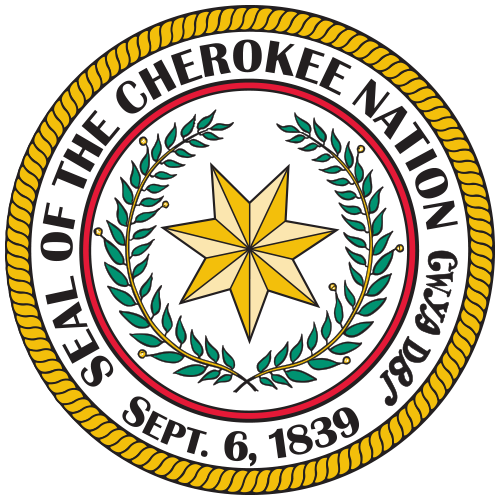
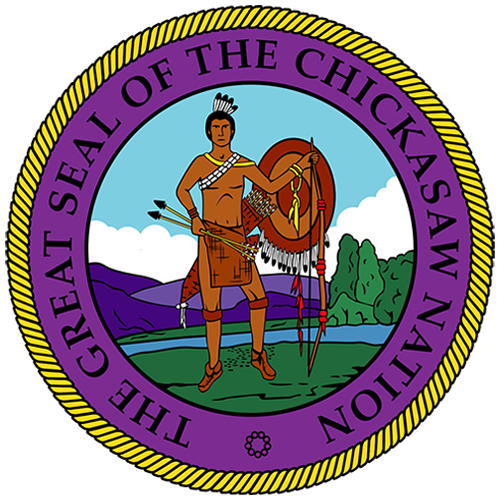
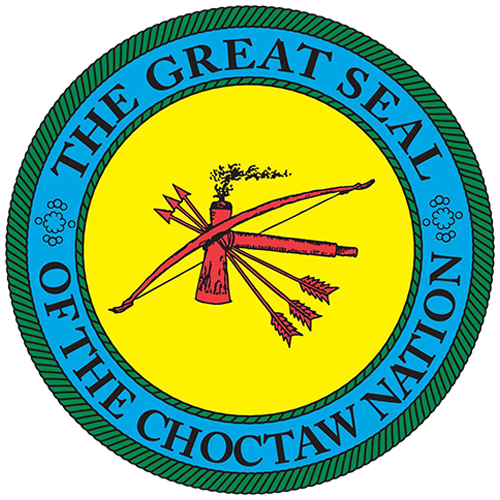
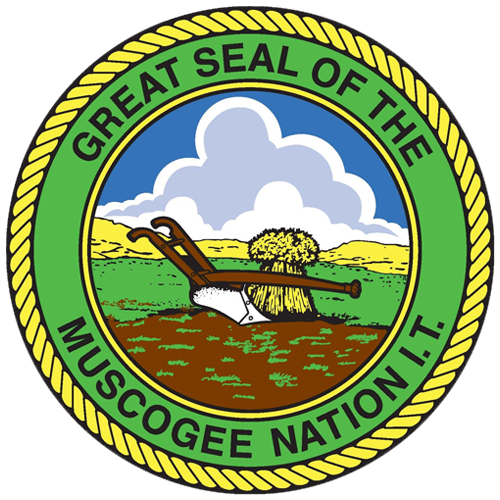
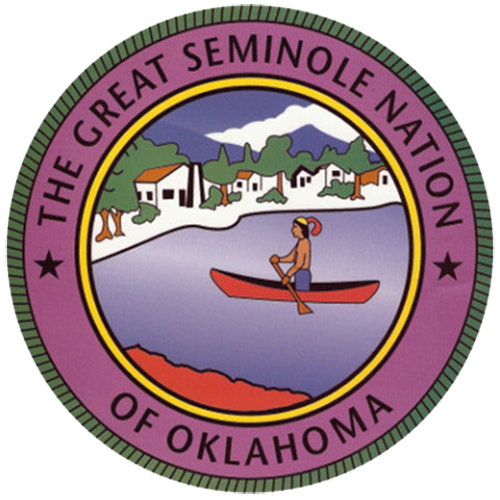
- Home
- Five Civilized Tribes
-
Council Documents
- Council Minutes
-
Resolutions
- Resolutions 1995
- Resolutions 1996
- Resolutions 1997
- Resolutions 1998
- Resolutions 1999
- Resolutions 2000
- Resolutions 2001
- Resolutions 2002
- Resolutions 2013
- Resolutions 2014
- Resolutions 2015
- Resolutions 2016
- Resolutions 2017
- Resolutions 2018
- Resolutions 2019
- Resolutions 2020
- Resolutions 2021
- Resolutions 2022
- Resolutions 2023
- Resolutions 2024
- Document Templates
Choctaw History
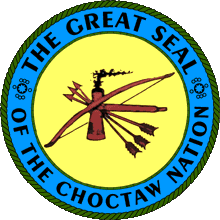 Choctaw Indian Nation traces its ancestry to Mississippi and some sections of Alabama. Legends tell that the Choctaw people originated from "Nanih Waya", a sacred hill near what is now known as Noxapter, Mississippi. "Nanih Waiya" means "Productive Mound" and is often referred to as "The Mother Mound".
Choctaw Indian Nation traces its ancestry to Mississippi and some sections of Alabama. Legends tell that the Choctaw people originated from "Nanih Waya", a sacred hill near what is now known as Noxapter, Mississippi. "Nanih Waiya" means "Productive Mound" and is often referred to as "The Mother Mound".
Culturally, the Choctaws have always honored their women as the head of every family household. They were, and still are today, considered the care-takers of our children, our elders, and the home.
The Choctaws were the first of the five great southern tribes of the United States to be moved to Oklahoma by the Treaty of Dancing Rabbit Creek in 1830. Over 20,000 Choctaws moved on this long journey, with many of the Choctaw people not surviving this removal on what has come to be called "THE TRAIL OF TEARS".
The Choctaws adjusted quickly to their new homeland. Missionaries were sent to Oklahoma Territory representing several denominations, including the Southern Baptists, Congregationalists, and Presbyterians. These missionaries established good rapport with the Choctaws, and early impressed upon the Choctaws the importance and need for formal education if they were to co-exist with the white man.
At that time there were three Districts in Oklahoma where the Choctaws resided; Pushmataha, Apukshunubbee and Mushulatubbee. Here, largely through the efforts of early missionaries, the Choctaws accepted an alien religion and code of morals, established a completely foreign educational system, adopted the constitution and legal system of an unrelated racial experience, and modified their agricultural and commercial practices to conform with a complex economic system.
The Choctaw "public school" system was started in 1821 before removal to what became Oklahoma. Immediately upon arrival to the western lands, schools began to spring up.
The Wheelock Academy was founded in 1831. One of the most prominent of the Choctaw schools was established in 1843 and known as Armstrong Academy. This academy for education of Indian youths was known as Armstrong Academy and was situated in the vicinity north of the present town of Bokchito, Bryan County, Oklahoma. When the Civil War broke out, the Choctaws moved their capitol to the Armstrong Academy so that it would be removed from the war zone. By 1883 the Choctaw Capitol had moved to Tuskahoma and Armstrong Academy was again used as a boarding school for orphaned Choctaw boys.
By 1894 Calvin Institute, another school for Indian youths, was established in Durant, Bryan County, Oklahoma. Though this school was to change its name twice more, by 1899 it had already attracted an enrollment of 300. The school eventually became known as Oklahoma Presbyterian College. This was accomplished shortly after Oklahoma was admitted to the Union as a State. The support for the school came from the Choctaw Tribe, the federal government, and several denominational missionary boards. Because of financial difficulties, the school was closed as a learning institution in the late 1960's.
The Chief, in 1975, wished to establish the Choctaw Nation administrative offices at the old Presbyterian College Building. Though the Capitol of the Choctaw Nation is recognized as being Tuskahoma, the administrative offices remain at the old Presbyterian College, formerly the old Calvin Institute. The Choctaws have strong ties with the school, being a part of their culture, history and religion, having served as one of the early educational institutions for their people.
In 1976, in cooperation with the Durant Chamber of commerce and the owners of the buildings, the Red River Valley Historical Association, title was transferred into the federal government. Impressive ceremonies were held August 17, 1976, commemorating the title transfer. Reacquisition of this building allowed centralization of government which permits more effective utilization of personnel in administering current programs and developing future programs. The building has been renovated and administration of many Choctaw programs are headquartered there.
Political Organization
Early Political Organization
The early political organization of the Choctaw Tribe can be described as a loose confederation of three political districts. Each of the districts had a District Chief who attained his position through demonstrated leadership potential, as was the case with Chief Pushmataha, although family inheritance had sometimes been the decisive factor. The District Chief would usually have one or two assistants to aid him in administrative matters.
Each town had its own Village Chief. In addition, each town had an Assistant Chief who organized the festivals, dances, and a War Chief who acted as leader of the town's warriors. It was customary for the War Chief to appoint two assistants who became the town's military captains.
Each District Chief called together a Council consisting of town representatives to consider matters of importance within his District. However, after a thorough discussion of the issues by Council members, the recommendations of the District Chief usually prevailed. The Council dealt in such matters as war and peace, and occasionally served as judge over civil matters. In times of crisis involving the entire Tribe, the three District Chiefs would meet to decide a common course of action.
However, before removal to "Oklahoma", the first Choctaw Constitution was written in 1825 and served as the governing document for the Tribe.
Early Oklahoma Political Organization
In 1829, the Mississippi State Legislature passed laws abolishing Choctaw Tribal Government and thereby extending the laws of Mississippi over Choctaws and their lands.
Recognizing the impossibility of managing their own affairs, the Tribe agreed to yield to increasing pressure by the U. S., Government to relocate on Indian territory west of the Mississippi River. The removal of the Tribe began in 1831 and was completed by 1833.
The three district divisions were retained in the new territory and were named after three outstanding district chiefs; Mushulatubbee, Pushmataha and Apuckshunubbee. At first, the three district chiefs continued to conduct the official business of the Tribe in Oklahoma under the 1825 Constitution. But in 1834 a second Constitution was adopted whereby all lawmaking authority was given to a general elected council of 27 members (9 from each district). The three district chiefs were given ex-officio status and any 2 of them could veto a law passed by the Council. However, this veto could be overridden by a 2/3rds majority of the Council. Several changes were made in the Choctaw Constitution during the following years. The first significant change was adding a House of Representatives and renaming the old council the Senate. This 1843 constitutional change provided for 4 Senators from each District to serve 4-year terms. However, House members were elected annually with the number to be apportioned to each District on the basis of population (similar to the U. S. system of government). This modified system did not work well because of the very slow-moving legislative process caused by the necessary two-house approval on every tribal consideration. Several conventions were held in the 1850s to develop a more workable system.
A new Constitution was adopted in 1860, which provided the 3 branches of government: legislative, executive and judicial. A Principal Chief was to be elected by all eligible voters of the Tribe, and provisions were also made for other national executive officers, including a National Secretary, National Treasurer, National Auditor, and National Attorney. The Senate and House of Representatives together comprised the National Council. Representation included 12 Senators, 4 from each District, and 18 Representatives. The 3 Judges of the Choctaw Supreme Court (1 from each District), were selected by the National Council for a term of 4 years. The election of District Chiefs, District Judges, and District Attorneys was continued under this Constitution.
The 3 Districts were now subdivided into counties, each with it's own set of county officers, including a judge, sheriff and ranger. Each official had special duties in administering Choctaw laws in his own county.
The Principal Chief concept was first established in the 1860 Constitution, the seventh Constitution of the Choctaw Nation. At that time the three district Chiefs were continued. This constitutional system of government, with a few minor revisions, prevailed until the abolition of the Choctaw National Government in 1906.
Present Political Organization
The Act of April 26, 1906 (34 Stat. 137) provided "the final disposition of the Affairs of the Five Civilized Tribes in Indian Territory and for other purposes". As one of the Five Civilized Tribes, the Choctaws are today still governed by the provisions of this Act.
The Act of 1860 greatly reduced the powers of the Choctaw Government, prescribing the powers and duties of the Principal Chief as being only to execute legal instruments on behalf of the Tribe. The Tribal Council remained intact but with a provision that it could not meet more than 30 days per year and it's legislation would have to have the approval of the Federal Government. Under the 1906 Act, the Tribal court system became powerless.
The Act of 1906 provided that the Principal Chief would hold the office unless removed by the President of the United States. Appointment of another Chief would result from the removal, disability or death of the incumbent.
An Act of October 22, 1970 (84 Stat. 1091) authorized each of the Five Civilized Tribes to popularly select their Principal Chief. The Choctaw Tribe held its first election in August, 1971, to select their Principal Chief Harry J. W. Belvin was elected to serve a term of 4 years. Prior to his election, Chief Belvin had already served as Principal Chief of the Choctaw Tribe for 23 consecutive years. In the 1975 election, C. David Gardner was elected Principal Chief. Upon his death, Chief Gardner was replaced by Hollis E. Roberts, who was chosen by popular vote. Following Chief Robers resignation, Chief Gregory E. Pyle was sworn into office on June 9, 1997.
In 1977, a small group of Choctaws placed into federal court a suit asking that the 1860 Choctaw Constitution be legally declared the valid Constitution of the Choctaw Nation. In 1979, the Choctaw people voted for and adopted a document which would serve as the guide for an interim government and the proposed Constitution. In 1981, the federal courts did declare that the 1860 Choctaw Constitution was valid. As a result, an updating of that Constitution was finished in a vote on July 9, 1983. The 1979 "proposed Constitution" was used as a companion document in the voting process.
There no longer is a "Principal" Chief of the Choctaw Nation. Instead, the leader of the Choctaws is now addressed as "Chief". The present Constitution allows for an Assistant Chief, who is appointed by the Chief and confirmed by the Tribal Council, and who serves as Chief at the death, removal or inability of the elected Chief to serve. Today the Choctaw Nation provides many services for the Indian people, including Housing programs, Health Services, Job training, Educational programs, Food programs and numerous others.
The historic Capitol Building at Tuskahoma houses the Choctaw Nation's Museum and Judicial Department Court System. the Museum has a wide assortment of historic and cultural exhibits, which include information and displays on the Choctaw Light Horsemen and the original Choctaw Code Talkers from World War I and World War II. The Light Horsemen were the Law Enforcement arm of the historic Choctaw Nation. In November, 1989, France presented the highest honor that country can bestow, "KNIGHT OF THE NATIONAL ORDER OF MERIT OF FRANCE", to the Choctaw Code Talkers for their efforts in World War I.
The Choctaw Capitol building is one of the outstanding Historical markers for the Choctaw Nation and hosts the annual Choctaw Nation Labor Day Festival.
The Annual Choctaw Labor Day celebration has become one of the largest and most attractive events in Oklahoma today. This event has become a continuing tradition among the Choctaw people, hosting thousands of visitors at the Historic Council House Grounds. Traditional cultural activities, annual Choctaw Princess Pageant, traditional foods, arts and crafts, sporting games, camping, fishing and musical entertainment are a few of the activities at the celebration. Chief Gregory E. Pyle and his family look forward each year to welcoming the Choctaw people to the festivities, as well as many visitors from all over the world.
Economic Development
The Choctaw Nation has become deeply involved in economic development enterprises, which have provided many jobs for Choctaws as well as revenues to supplement the programs and services.
In December, 1987, the Choctaw Nation opened the doors of their 28,000 square foot CHOCTAW BINGO PALACE and became the first American Indian Bingo Hall to have a ONE MILLION DOLLAR WINNER. Choctaw Bingo facilities have since been placed in operation at the Arrowhead Resort in Canadian, Oklahoma, the Choctaw Village Shopping Center in Idabel, Oklahoma, and the latest Bingo facility was opened in 1994 at Pocola, Oklahoma. These facilities provide employment for over 200 Indian people.
The first Choctaw Travel Plaza and Smoke Shop was opened in Durant, Oklahoma, in 1990, and currently generates an average of $1.5 million in gross sales each month.
Smokes Shops are also located at Pocola, Oklahoma, and at the Choctaw Village Shopping Center in Idabel, Oklahoma. Another Travel Plaza and Smoke Shop is under construction at Durant as the first facility is at capacity with no room for expansion, a Travel Plaza and Smoke Shop is presently under construction just south of Hugo, Oklahoma, and construction will begin shortly on a Travel Plaza/Smoke Shop facility just south of McAlester, Oklahoma. Each Travel Plaza/Smoke Shop provides full time employment for at least 31 individuals.
In 1990 the Choctaw Nation purchased a shopping center in Idabel, Oklahoma. The Shopping Center has 37 tenants, including a Dairy Queen, Piggly Wiggly Supermarket, Subway Sandwich Shop, and Dollar General Store. A Smoke Shop has been constructed at the Shopping Center, and the center now provides 10 full-time jobs.
Other economic development enterprises owned by the Tribe include the Arrowhead Resort Hotel and Gaming Center at Canadian, Oklahoma, and the Choctaw Nation Finishing Company at Hugo, Oklahoma, which provide employment for approximately 75 individuals.
Under the leadership of Chief Gregory E. Pyle and the twelve elected Tribal Council Representatives, the Choctaw Nation has established a positive direction of Tribal Government for the benefit of the Choctaw People.